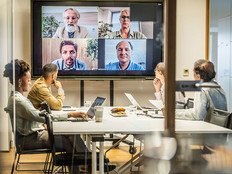BRAC to the Future

Kyle Bond is on the move.
For eight years, the 32-year-old Bond taught video and radio production to New Jersey high schoolers. Now he works as a federal contract employee helping Army personnel add multimedia content to their cyber training and presentation materials. As one of approximately 200,000 military and civilian personnel affected by the 2005 Base Realignment and Closure (BRAC) recommendations, Bond is also taking part in one of the biggest domestic military operations in modern times.
Bond volunteered to be an “early mover,” relocating from Fort Monmouth, N.J., to the Aberdeen Proving Ground in northeast Maryland well before the bulk of the Army’s Communications and Electronics Command (CECOM) moves in 2011. He’s not even sure if he has an office to move into yet. But Bond, who spends roughly half his time on the road, says “give me an AC outlet and Internet access, that’s all I really need.”
This is hardly the first time the U.S. military has moved to consolidate operations, close down some bases and realign others. There were four BRAC initiatives prior to 2005. But this BRAC is by far the biggest and the most complex — in part because of the military’s increased dependence on technology. And BRAC 2005 in turn will force the military to abandon legacy applications, modernize its tech infrastructure and acquire new skill sets, notes John Thomas, director of EMC’s strategic programs for the Defense Department.
“The last time the military went through BRAC, it was 10 to 15 years ago,” says the retired Army colonel. “Back then, they hardly had any IT to worry about — mostly notebooks and servers. And when a unit was moved, the equipment just moved with them. Now, everything they do is dependent on an IT infrastructure. The expectation is that they’ll always have access to that information.”
Moving Plan
— Craig College, Deputy Assistant
Chief of Staff for Installation
Management, Army
The problem is the military can’t simply pick up a machine and move it, says Thomas, because they risk breaking something else in the enterprise. That machine may be a virtual server providing different applications to different units, not all of which will be moving at the same time, or it could be dependent on data residing on other machines on the network. Move one piece without knowing the interdependencies, and the whole system begins to break down.
So Thomas has spent part of the past several months educating Army IT personnel in the intricacies of data center management and migration — identifying technology assets, mapping interdependencies and planning for systems consolidation.
“The technological challenges here are huge,” he says. “Private industry does this sort of thing all the time, but this is a new thing for the military. I’m concerned that when push comes to shove, they might resort to the U-Haul truck method: Pull the machines out, reinstall them in the new location and hope they work. Without proper mapping and consolidation planning, the result could be chaos.”
Thomas says BRAC is also likely to accelerate the military’s adoption of technologies such as virtualization and cloud computing, to avoid problems with having to maintain data in two or more physical locations, especially as units move. That will also require training in new skills.
“In not so subtle ways, IT is both a major beneficiary of BRAC as well as a major enabler,” says Raymond DuBois, senior adviser at the Center for Strategic and International Studies. “In the past, it used to be the military had to figure out how to make its legacy systems more efficient. Now, they can start with a clean slate.”
Millennials, Front and Center
Claudia DeCarlo, deputy chief knowledge officer for operations for the Army’s Program Executive Office for Command, Control and Communications Tactical (PEO C3T), says the military is actively seeking to train personnel in Web 2.0 communications technologies such as blogs, wikis, web conferencing and social networks.

wants to “provide Web 2.0
technologies that the upcoming
generation uses in their everyday
lives,” says the service’s
Claudia DeCarlo.
“PEO C3T is working with Army Knowledge Online/Defense Knowledge Online to provide Web 2.0 technologies that the upcoming generation uses in their everyday lives,” she says. “For the existing workforce, PEO C3T provides training on how to use these tools to increase productivity, meet critical business challenges and improve knowledge management, for the ultimate goal of improving our support to the warfighter.”
Another unintended consequence of BRAC will likely be a major turnover in the military’s aging workforce. In a survey conducted last year, 30 percent of personnel slated to move to Aberdeen said they are unwilling to relocate; the majority of those will be at or near retirement at the time of the move. This presents an opportunity to bring in a new generation with fresh tech skills, says DuBois.
“There’s always a certain percentage of people who won’t be willing to move,” he says. “As the Army moves CECOM from Fort Monmouth to Aberdeen, they’ll be able to take advantage of new hires, some of whom are more computer literate than the personnel they’re replacing. That will help the military take advantage of the technological advancements that have come down the pike over the last few years. In my humble estimation, this is a positive aspect of BRAC.”
Training — On the Spot
But while new personnel may be younger and more web savvy, they’ll continue to need training in all aspects of operations. Much of that will happen at the computer itself.
“You sit down at the computer and begin to use an application, and it trains you,” explains DuBois. “You don’t have to go off and attend a class or use a distance-learning course because the training is embedded in the application itself.”
Bond says a big part of his new job with the service focuses on creating materials to keep Army personnel abreast of changes in technology.
“I know the tools we’re training them to use help them do their jobs more efficiently and find better ways to communicate,” he says. “We’re trying to do everything we can to support the warfighter. That’s our primary role.”
|
Movers and Shakers BRAC 2005 affects more than 800 military installations in the United States. Some bases will gain personnel, others will lose. Here are the five biggest winners and losers. |
||
|
+ Gains
|
||
| Base | Location | Net Gain (Loss) |
| Fort Belvoir | Virginia | 11,858 |
| Fort Bliss | Texas | 11,501 |
| Fort Benning | Georgia | 9,839 |
| Fort Sam Houston | Texas | 9,364 |
| Fort Lee | Virginia | 7,344 |
|
- LOSSES
|
||
| Submarine Base New London | Connecticut | (8,460) |
| Walter Reed Army Medical Center | District of Columbia | (5,630) |
| Fort Monmouth | New Jersey | (5,272) |
| Naval Shipyard Portsmouth | Maine | (4,510) |
| Pope Air Force Base | North Carolina | (4,145) |
|
SOURCE: Defense Department |
||







